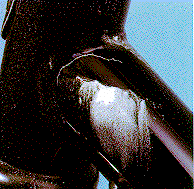The photograph shows a fatigue crack in the frame tube of a bicycle. The crack starts in
a frame tube joint region and then propagates under the fluctuating stresses from road shocks into the tube. In this picture the crack has been made visible by filling it with chalk dust. An alternative is to use a liquid fluorescent dye that will soak into the crack and can be seen when the tube surface is wiped clean and the bike illuminated with ultra-violet light. The mechanism of crack propagation in a metal frame tube is the same as that for the spokes considered above, and the crack will grow until a critical crack length is reached at which point the tube will fail by fast fracture.

From: Apps, "The Bicycle
Book,"
Smithmark (1996)
For steel frame tubes there is a 'fatigue limit' - - a stress value below which the fatigue life of the component is essentially infinite. If the tubes are of aluminum alloy, the fatigue lifetime increases as the maximum applied fatigue stress is reduced. The frame tubes are also susceptible to stress concentration due to corrosion or local surface damage. Tube shape and wall thickness may be selected so as to reduce maximum tensile stresses and increase fatigue life and decrease tube deformation under load.
| Materials |
| Menu |
| Prev |
| Next |